Ditapis dengan

Course Outline & Reader : Shipping and Transport Introduction
- Edisi
- Shipping and Transport Introduction
- ISBN/ISSN
- -
- Deskripsi Fisik
- illus,; 30 cm
- Judul Seri
- Shipping and Transport Introduction
- No. Panggil
- CC STC COU s C1
- Edisi
- Shipping and Transport Introduction
- ISBN/ISSN
- -
- Deskripsi Fisik
- illus,; 30 cm
- Judul Seri
- Shipping and Transport Introduction
- No. Panggil
- CC STC COU s C1

Syllabus : Transport Security
- Edisi
- Transport Security
- ISBN/ISSN
- -
- Deskripsi Fisik
- illus,; 30 cm
- Judul Seri
- -
- No. Panggil
- CC STC SYL t C1
- Edisi
- Transport Security
- ISBN/ISSN
- -
- Deskripsi Fisik
- illus,; 30 cm
- Judul Seri
- -
- No. Panggil
- CC STC SYL t C1

Transport Security
- Edisi
- Transport Security
- ISBN/ISSN
- -
- Deskripsi Fisik
- 64 page
- Judul Seri
- Transport Security
- No. Panggil
- CC STC MOD t C1
- Edisi
- Transport Security
- ISBN/ISSN
- -
- Deskripsi Fisik
- 64 page
- Judul Seri
- Transport Security
- No. Panggil
- CC STC MOD t C1

Presentations : Trasnportation Law
- Edisi
- Trasnportation Law
- ISBN/ISSN
- -
- Deskripsi Fisik
- 37 page
- Judul Seri
- Trasnportation Law
- No. Panggil
- CC STC PRE TRA C1
- Edisi
- Trasnportation Law
- ISBN/ISSN
- -
- Deskripsi Fisik
- 37 page
- Judul Seri
- Trasnportation Law
- No. Panggil
- CC STC PRE TRA C1

The role of Panama Canal in global shipping
Abstract Purpose – The purpose of this study is to find out the future development of the Panama Canal after opening of the new waterway (third set of locks project), in terms of the change of cargo throughput, further deployment of fleets by the shipping companies and competition for the canal.
- Edisi
- Maritime Business Review
- ISBN/ISSN
- -
- Deskripsi Fisik
- 15 halaman
- Judul Seri
- The role of Panama Canal in global shipping
- No. Panggil
- ATC PO MAR a

Nonlinear three-port magnetic-circuit elements for simulating bending magnets
Purpose – The purpose of this paper is to show that constructing magnetic equivalent circuits (MECs) for simulating accelerator magnets is possible by defining a three-port magnetic element for modelling the T-shape field distribution, where the flux leaves the yoke and enters the aperture. Design/methodology/approach – A linear three-port magnetic element is extracted from an analytical fi…
- Edisi
- COMPEL - The international journal for computation
- ISBN/ISSN
- -
- Deskripsi Fisik
- 16 halaman
- Judul Seri
- Nonlinear three-port magnetic-circuit elements for simulating bending magnets
- No. Panggil
- ATC PO HER a

2011 ESP Code : International code on the enhanced programme of inspections d…
- Edisi
- 2013 Ed.
- ISBN/ISSN
- 978-92-801-1552-9
- Deskripsi Fisik
- vii, 294 p., 33 cm
- Judul Seri
- -
- No. Panggil
- REF MR IMO t
- Edisi
- 2013 Ed.
- ISBN/ISSN
- 978-92-801-1552-9
- Deskripsi Fisik
- vii, 294 p., 33 cm
- Judul Seri
- -
- No. Panggil
- REF MR IMO t
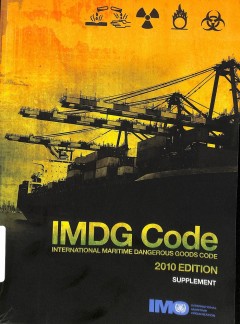
IMDG Code : International maritime dangerous goods code
The International Maritime Dangerous Goods Code lays out the regulatory framework for all aspects of handling dangerous goods and marine pollutants in sea transport, but does not include all details of procedures for packing of dangerous goods or actions to take in the event of an emergency or accident involving personnel associated with the IMDG Code that cover these aspects of the transport o…
- Edisi
- 2010 Editions
- ISBN/ISSN
- 978-92-801-1514-7
- Deskripsi Fisik
- v, 441 hlm., 33 cm
- Judul Seri
- -
- No. Panggil
- REF MR IMO i
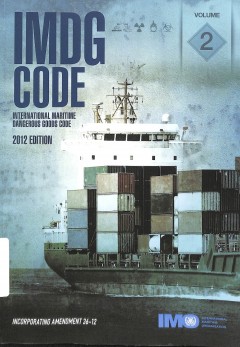
IMDG Code : International maritime dangerous goods code Volume 2
- Edisi
- 2012 Ed. Vol. 2
- ISBN/ISSN
- 978-92-801-1561-1
- Deskripsi Fisik
- v, 369 p., 28 cm
- Judul Seri
- -
- No. Panggil
- REF MR IMO i
- Edisi
- 2012 Ed. Vol. 2
- ISBN/ISSN
- 978-92-801-1561-1
- Deskripsi Fisik
- v, 369 p., 28 cm
- Judul Seri
- -
- No. Panggil
- REF MR IMO i
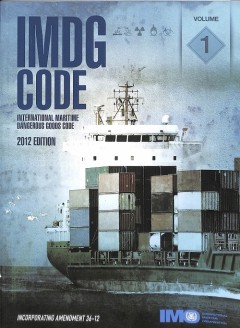
IMDG Code : International maritime dangerous goods code Volume 1
- Edisi
- 2012 Ed. Vol. 1
- ISBN/ISSN
- 978-92-801-15611
- Deskripsi Fisik
- xiv, 481 p., 33 cm
- Judul Seri
- -
- No. Panggil
- REF MR IMO i
- Edisi
- 2012 Ed. Vol. 1
- ISBN/ISSN
- 978-92-801-15611
- Deskripsi Fisik
- xiv, 481 p., 33 cm
- Judul Seri
- -
- No. Panggil
- REF MR IMO i

Proficiency in survival craft and rescue boats other than fast rescue boats
The purpose of the IMO model courses is to assist maritime training institutes and their teaching staff in organzing and introducing new training courses, or in enching, updating or supplementing existing training material where the quality and effectiveness of the training course may thereby be improved
- Edisi
- 2000 Ed.
- ISBN/ISSN
- 978-92-801-6115-1
- Deskripsi Fisik
- v, 68 p., 33 cm
- Judul Seri
- -
- No. Panggil
- TXT PO IMO p
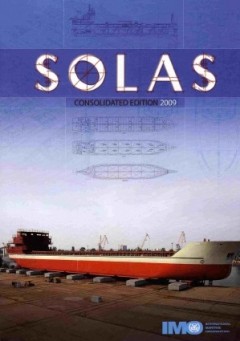
Solas : consolidated edition 2009
Of all the international conventions dealing with maritime safety, the most important is the International Convention for the Safety of Life at Sea, better known as SOLAS, which covers a wide range of measures designed to improve the safety of shipping. The Convention is also one of the oldest of its kind: the first version was adopted in 1914 following the sinking of the Titanic with the loss …
- Edisi
- Fifth Edition
- ISBN/ISSN
- 978-92-801-1505-5
- Deskripsi Fisik
- viii, 418 hlm., 33 cm
- Judul Seri
- -
- No. Panggil
- TXT MR IMO s
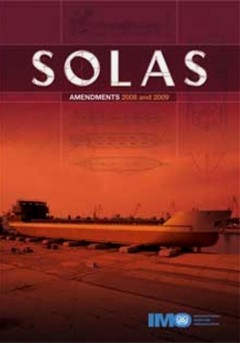
Solas : Amendments 2008 and 2009
- Edisi
- -
- ISBN/ISSN
- 978-92-801-1520-8
- Deskripsi Fisik
- viii, 78 p., 21 cm
- Judul Seri
- -
- No. Panggil
- TXT MR IMO s
- Edisi
- -
- ISBN/ISSN
- 978-92-801-1520-8
- Deskripsi Fisik
- viii, 78 p., 21 cm
- Judul Seri
- -
- No. Panggil
- TXT MR IMO s

General operator's certificate for the global maritime distress and safety sy…
- Edisi
- 2004 Ed.
- ISBN/ISSN
- 978-92-801-4181-8
- Deskripsi Fisik
- v. 368 p., 33 cm
- Judul Seri
- Model Course 1.25
- No. Panggil
- MR IMO g
- Edisi
- 2004 Ed.
- ISBN/ISSN
- 978-92-801-4181-8
- Deskripsi Fisik
- v. 368 p., 33 cm
- Judul Seri
- Model Course 1.25
- No. Panggil
- MR IMO g
safety and shipping review 2013
In 2012, two high profile maritime incidents pushed shipping safety into the public eye once more with the loss of the Costa Concordia off Italy in January followed in February by that of the Rabaul Queen ferry, off Papua New Guinea. Both events caused a tragic loss of life. However, while these incidents have dominated public ship safety discussions, statistics reveal that reported total losse…
- Edisi
- -
- ISBN/ISSN
- -
- Deskripsi Fisik
- 13 pages
- Judul Seri
- An annual review of trends and developments in shipping losses and safety – January 2013
- No. Panggil
- TXT LO ALI s

Simulation and analysis for the kelang container terminal operations
Key issues of the application of modelling and simulation for the management of the Malaysian Kelang Container Terminal are discussed. The aim of the investigation is to improve the logistics processes at the port. The model simulates all processes required to operate the seaport efficiently and provides detailed statistics on the seaport through‐put and utilisation characteristics with a hig…
- Edisi
- Vol. 13 Iss 1 pp. 14 - 20
- ISBN/ISSN
- 0957-6053
- Deskripsi Fisik
- 9 p.
- Judul Seri
- -
- No. Panggil
- ATC PO TAH s

Simulation and analysis for the Kelang Container Terminal operations
Key issues of the application of modelling and simulation for the management of the Malaysian Kelang Container Terminal are discussed. The aim of the investigation is to improve the logistics processes at the port. The model simulates all processes required to operate the seaport efficiently and provides detailed statistics on the seaport through‐put and utilisation characteristics with a hig…
- Edisi
- Vol. 13 Issue: 1, pp.14-20
- ISBN/ISSN
- -
- Deskripsi Fisik
- 9 p.
- Judul Seri
- Logistics Information Management
- No. Panggil
- ATC LO HUS s

An assessment of the integration of seaports into supply chains using a struc…
The changing role of seaports in supply chains has been the subject of extensive research in the recent literature. The strategic development of seaport terminals, responding to the need for closer integration into supply chains, invites a more detailed examination of the influence of the supply chain structures on seaport performance. Therefore, this paper aims to investigate the effects of su…
- Edisi
- Vol. 18 Iss 3 pp. 235 - 252
- ISBN/ISSN
- 1359-8546
- Deskripsi Fisik
- 20 p.
- Judul Seri
- Supply Chain Management: An International Journal
- No. Panggil
- ATC LO WOO a

Port-centric logistics
The purpose of this paper is to examine traditional, current and emerging roles played by ports in the context of logistics and supply chain management practice and strategy. The paper also seeks to elaborate the emerging concept of port-centric logistics.
- Edisi
- Vol. 19 No. 1, 2008
- ISBN/ISSN
- -
- Deskripsi Fisik
- 18 p.
- Judul Seri
- The International Journal of Logistics Management
- No. Panggil
- ATC LO MAN p

Port-centric logistics
The purpose of this paper is to examine traditional, current and emerging roles played by ports in the context of logistics and supply chain management practice and strategy. The paper also seeks to elaborate the emerging concept of port-centric logistics.
- Edisi
- Vol. 19 No. 1, 2008 pp. 29-41
- ISBN/ISSN
- -
- Deskripsi Fisik
- 18 p.
- Judul Seri
- The International Journal of Logistics Management
- No. Panggil
- ATC LO FYN p

PCS interoperability in Europe: a market for PCS operators?
Purpose – The purpose of this paper is to discuss the evolution of local port community systems (PCS) towards a vast network of interlinked locations in Europe. Design/methodology/approach – The paper is conceptual. It builds on the findings of platform theory and the analogy between the market for cargo information and the payment system industry to discuss the potential outcomes and shape…
- Edisi
- vol. 24
- ISBN/ISSN
- -
- Deskripsi Fisik
- 14 pages
- Judul Seri
- The International Journal of Logistics Management
- No. Panggil
- ATC PO BAR p

PCS interoperability in Europe: a market for PCS operators?
The purpose of this paper is to discuss the evolution of local port community systems (PCS) towards a vast network of interlinked locations in Europe.
- Edisi
- Vol. 24 No. 1, 2013 pp. 117-129
- ISBN/ISSN
- -
- Deskripsi Fisik
- 14 p.
- Judul Seri
- The International Journal of Logistics Management
- No. Panggil
- ATC LO LAU p

Maritime Transport Security : Issues, Challenges and National Policies
This important book presents a profound analysis of the current challenges and policies related to the growing concern of maritime transport security, covering all aspects, from terrorism, in general, to piracy, in particular. It is a comprehensive work that offers a multidisciplinary view on the main themes and issues in this relatively unexplored field. It also provides several case studies t…
- Edisi
- -
- ISBN/ISSN
- 978-1-78195-496-6
- Deskripsi Fisik
- viii, 299 p, 21 cm
- Judul Seri
- -
- No. Panggil
- TXT MR KHA m

A forgotten history The impacts of globalization on Norwegian seafarers’ sh…
Purpose – The purpose of this paper is to explore the lessons of globalization from the standpoint of Norwegian seafarers' career experiences. An isolated and multicultural shipboard social milieu provides a unique context for examining the challenges and impacts associated with globalized work. Design/methodology/approach – Descriptions of the historical contexts of globalization, Nor…
- Edisi
- Vol. 16 Iss: 2, pp.253 - 269
- ISBN/ISSN
- 1751-1348
- Deskripsi Fisik
- 19 pages
- Judul Seri
- Journal of Management History
- No. Panggil
- ATC MR MAC a

Safety and shipping review 2015
Safety of international shipping vessels is critical to the global economy. More than 90% of trade is estimated to be transported by sea. The maritime industry continued to improve its safety record in 2014 with 75 total losses reported worldwide; the lowest in 10 years. Losses declined by 32% compared with 2013 (110). The 2014 accident year also represents a significant improvement on the 10-y…
- Edisi
- -
- ISBN/ISSN
- -
- Deskripsi Fisik
- 36 pages
- Judul Seri
- -
- No. Panggil
- TXT LO ALI s

The transport selection criteria of Norwegian exporters
Examines transport selection criteria with particular reference to Norwegian exports. Because results of studies of carrier selection determinants tend to have a degree of consensus, there is a risk of assuming context‐free determinants, whereas throughout the world there is a range of contexts that may influence determinants. Norway has distinctive features including export dependency with…
- Edisi
- Vol. 28 Issue: 2, pp.108-120
- ISBN/ISSN
- -
- Deskripsi Fisik
- 15 p.
- Judul Seri
- International Journal of Physical Distribution & Logistics Management
- No. Panggil
- ATC LO LOE t

Quality assurance in the maritime port logistics chain: the case of Valencia,…
The provision of port services is an important link in international logistics. Historically, ports have constituted a bottleneck in maritime transport. Moreover, the quality of port services has been compromised by the complex internal port organisation and the considerable number of bodies that participate in the transfer of goods between ships and inland transport vehicles. The efficiency of…
- Edisi
- Vol. 3 Issue: 1, pp.33-44
- ISBN/ISSN
- -
- Deskripsi Fisik
- 14 p.
- Judul Seri
- Supply Chain Management: An International Journal
- No. Panggil
- ATC LO COM q
 Karya Umum
Karya Umum  Filsafat
Filsafat  Agama
Agama  Ilmu-ilmu Sosial
Ilmu-ilmu Sosial  Bahasa
Bahasa  Ilmu-ilmu Murni
Ilmu-ilmu Murni  Ilmu-ilmu Terapan
Ilmu-ilmu Terapan  Kesenian, Hiburan, dan Olahraga
Kesenian, Hiburan, dan Olahraga  Kesusastraan
Kesusastraan  Geografi dan Sejarah
Geografi dan Sejarah